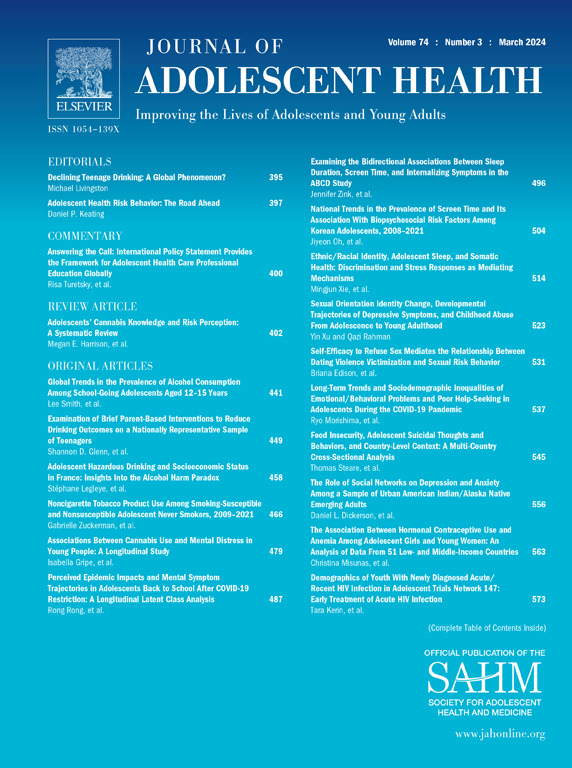TikTok视频中的信息框架和来源对青少年戒烟的影响:情感和感知信息有效性作为中介机制。
IF 5.5
2区 医学
Q1 PEDIATRICS
引用次数: 0
摘要
目的:本研究的目的是评估信息框架(获得与失去)和信息来源(正式专家:医疗保健专业人士与非正式专家:成功戒烟的个人)对目前使用电子烟的青少年中TikTok视频说服力的影响。此外,该研究还考察了情感反应和感知信息有效性(PME)如何调节框架效应对青少年戒烟意向的影响:方法:对 378 名年龄在 13 至 18 岁之间、目前使用电子烟的青少年进行了 2(收益框架 vs. 损失框架)×2(正式专家 vs. 非正式专家)因子设计实验。研究测量了参与者的情绪反应、对信息的PME以及观看视频后戒烟的意愿:结果:与来自非正式专家的信息相比,来自正式专家的信息会增强戒烟意愿。由非正式专家传达的收益框架信息与更高的PME相关,而由正式专家传达的损失框架信息对PME的影响更大。积极的情绪反应和更高的PME调节了收益框架信息与青少年戒烟意向之间的关系:TikTok可以作为正规专家向使用电子烟的青少年宣传戒烟的有效工具。此外,研究结果表明,在促进青少年戒烟方面,获得信息框架可能比失去信息框架更有影响力,因为它能引起受众的积极情感反应。信息框架的不同影响取决于信息源类型,这表明内容与信息传递者之间存在着微妙的互动关系。本文章由计算机程序翻译,如有差异,请以英文原文为准。
Effects of Message Frames and Sources in TikTok Videos for Youth Vaping Cessation: Emotions and Perceived Message Effectiveness as Mediating Mechanisms
Purpose
The objective of this study was to evaluate the effect of message frames (gain vs. loss) and sources (formal expert: a health-care professional vs. informal expert: an individual who successfully quit vaping) on the persuasiveness of TikTok videos among youth who currently use e-cigarettes. Additionally, the study examined how emotional responses and perceived message effectiveness (PME) mediate the framing effect on youth intention to quit vaping.
Methods
A 2 (gain frame vs. loss frame) × 2 (formal expert vs. informal expert) factorial design experiment was conducted with 378 youth aged 13 to 18 who currently use e-cigarettes. The study measured participant's emotional responses, PME of the messages, and intention to quit vaping after the video exposure.
Results
Messages from a formal expert resulted in stronger intention to quit vaping compared to messages from an informal expert. Gain-framed messages were associated with higher PME when delivered by an informal expert, whereas loss-framed messages showed stronger effects on PME from a formal expert. Positive emotional responses and increased PME mediated the relationship between gain-framed messages and youth intention to quit vaping.
Discussion
TikTok could serve as an effective tool for formal experts to promote vaping cessation among youth who use e-cigarettes. Additionally, the findings suggest that gain frames may be more influential than loss frames in promoting vaping cessation among youth, by eliciting positive emotional responses from the audience. The differential impact of message frames depending on source type indicates a nuanced interaction between content and messenger.
求助全文
通过发布文献求助,成功后即可免费获取论文全文。
去求助
来源期刊

Journal of Adolescent Health
医学-公共卫生、环境卫生与职业卫生
CiteScore
10.40
自引率
3.90%
发文量
526
审稿时长
46 days
期刊介绍:
The Journal of Adolescent Health is a scientific publication dedicated to enhancing the health and well-being of adolescents and young adults. Our Journal covers a broad range of research topics, spanning from the basic biological and behavioral sciences to public health and policy. We welcome a variety of contributions, including original research papers, concise reports, literature reviews, clinical case reports, opinion pieces, and letters to the editor. We encourage professionals from diverse disciplines such as Anthropology, Education, Ethics, Global Health, Health Services Research, Law, Medicine, Mental and Behavioral Health, Nursing, Nutrition, Psychology, Public Health and Policy, Social Work, Sociology, and Youth Development to share their expertise and contribute to our mission of promoting adolescent health. Moreover, we value the voices of young individuals, family and community members, and healthcare professionals, and encourage them to submit poetry, personal narratives, images, and other creative works that provide unique insights into the experiences of adolescents and young adults. By combining scientific peer-reviewed research with creative expressions, our Journal aims to create a comprehensive understanding of the challenges and opportunities in adolescent and young adult health.
 求助内容:
求助内容: 应助结果提醒方式:
应助结果提醒方式:


